Four egg-cellent recipes from Silvia Colloca's new cookbook Italian Home Cook
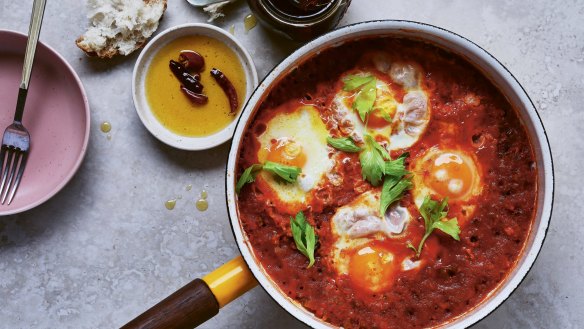
Italians are natural, inventive home cooks, but their creativity is expressed more with thrift and ingenuity than with sophistication, Italian-born television personality Silvia Colloca writes in the introduction to her latest cookbook, The Italian Home Cook.
"It takes far more imagination to cook a delicious meal out of just three or four ingredients and a wooden spoon than it does using 15 ingredients and as many kitchen gadgets."
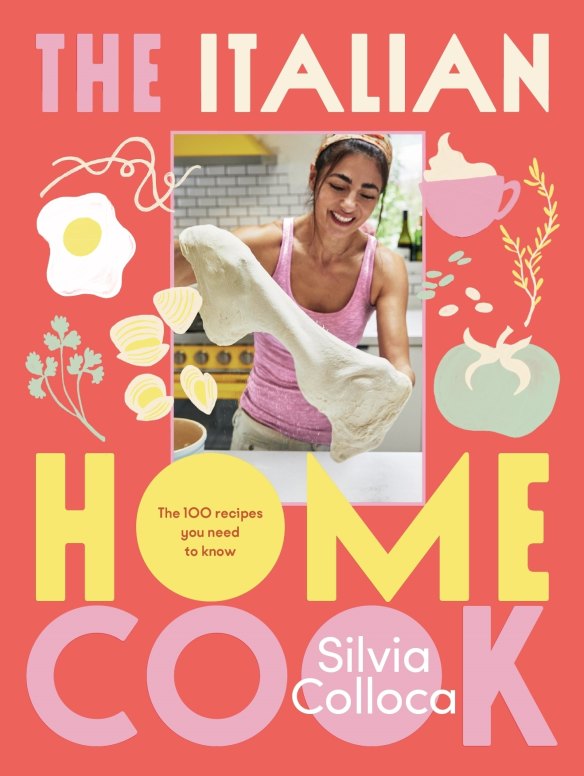
And so it is that many Italian recipes revolve around eggs, which occupy a special place in the kitchen – and heart – of the Italian home cook. "On those days when both fridge and pantry seem desolate and empty, if there are eggs in the fridge, there's a meal."
Here are some of her favourite egg-based recipes.
Uova alla contadina (eggs poached in tomato sugo)
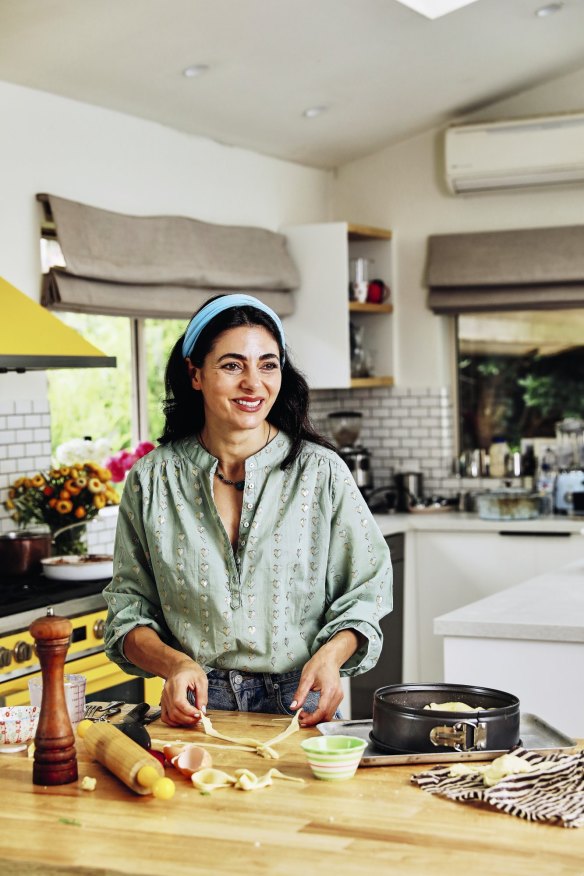
This is one of the signature dishes of Nonna Irene (my mum's mamma). She would always make a large batch of sugo for Sunday pasta, and the leftover sauce was the perfect poaching liquid for eggs. The name "alla contadina" means farmers' style, an expression used in many no-fuss recipes in the Italian home-cooking repertoire. Clearly, contadini don't have time to indulge in elaborate courses – they need something fast, nutritious and delicious, and this Italian-style shakshuka fits the bill perfectly.
INGREDIENTS
- 3 tbsp extra virgin olive oil
- 2 golden shallots, finely chopped
- 1 small celery stalk, thinly sliced
- 1 tsp 'nduja (see note)
- 1⁄4 red capsicum, deseeded
- 400g can crushed tomatoes (or passata)
- 1 small piece of parmigiano rind
- 4 eggs
To serve
- salt flakes
- freshly grated parmigiano (optional)
- celery leaves
- chilli oil
- crusty bread
METHOD
- Heat the olive oil in a wide saucepan over medium heat. Add the shallot, celery, 'nduja and capsicum and cook, stirring occasionally, for 2-3 minutes or until the shallot is softened and golden.
- Add the tomatoes, cheese rind and 200ml of water to the pan and bring to the boil. Reduce the heat to low and simmer gently for 15-20 minutes or until slightly reduced. (You can either discard the piece of capsicum or leave it in – it is simply there to impart extra flavour.)
- Make four indentations in the sugo with the back of a spoon. Crack the eggs, one by one, into the indentations and cook for 6-8 minutes – just enough to set the whites but keep the yolks runny, or cook for longer if you prefer your eggs more set. (You will notice that eggs poached in a sauce take a bit longer than poaching in water.)
- Remove from the heat, season with salt to taste and dust with some grated parmigiano, if you like. Top with a few celery leaves, drizzle with chilli oil and serve with plenty of crusty bread.
Note 'Nduja is a spicy salami, chilli and garlic paste typical of Calabria, in Italy's south. It is often used as a flavouring in stews and sauces or even spread on toasted bread.
Serves 4
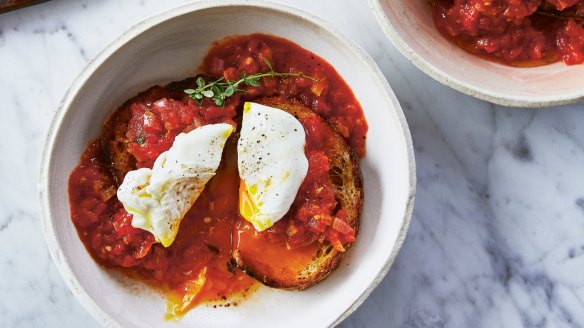
Acquacotta (Tuscan tomato broth)
If you rely on the literal translation of "acquacotta" – cooked water – I admit this soupy concoction doesn't sound very promising. However, if you are familiar with the delicious simplicity of Italian home cooking, you'll know too well that behind this unassuming name hides a delectable dish that has been kept in cooks' repertoires over the centuries. Acquacotta may have originated in the Middle Ages, when the local mandriani (cowboys) would cook up onions in fat, add water and bread, crack in an egg and call it dinner. Over the years tomatoes were added, giving this dish an attractive makeover, both in flavour and appearance. Think of it as poached eggs in a tomato and onion base, served with stale bread and lashings of olive oil.
INGREDIENTS
- 3 tbsp extra virgin olive oil, plus extra to serve
- 1 large onion or 2 golden shallots, finely chopped
- 1 celery stalk, finely chopped
- salt flakes and freshly ground white or black pepper
- 2 × 400g cans peeled tomatoes, crushed with a fork or potato masher
- 1-2 thyme sprigs, plus extra to serve
- 2 tbsp white wine vinegar
- 4 eggs
- 4 slices of stale bread, such as ciabatta or sourdough
METHOD
- Heat the olive oil in a large heavy-based saucepan over medium heat. Add the onion or shallot, celery and a pinch of salt and cook for 3-4 minutes or until softened. Add the tomatoes, 200ml of water and the thyme sprigs, season with salt and bring to a simmer. Cook for 20-25 minutes or until slightly reduced and thickened. Taste for seasoning and adjust to your liking.
- Fill a deep frying pan with water and bring to a simmer over medium heat. Add the vinegar and stir to combine, then gently crack in an egg, swirl the water around with a spoon and poach the egg for 3 minutes for a runny yolk. Remove with a slotted spoon and drain on paper towel. Repeat to poach the remaining eggs.
- Heat a chargrill pan to hot, then place the slices of bread in the pan and cook for a few minutes each side until charred. Place the bread in serving bowls, then ladle in the tomato sauce (the bread is there to soak up the sauce) and top each bowl with a poached egg. Season with a little extra salt and pepper and serve with some extra sprigs of thyme.
Serves 4
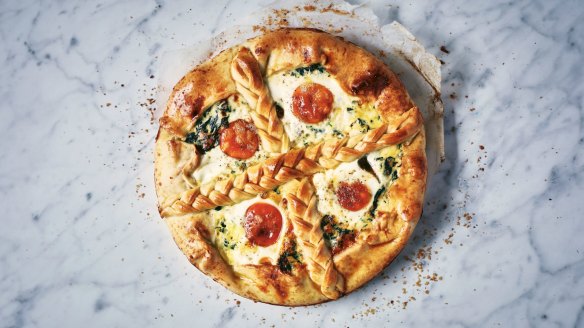
Torta Pasqualina (egg, ricotta and spinach pie)
This savoury pie is traditionally made for Easter ("Pasqua" in Italian), but can be enjoyed all year round so long as you have bitter green leaves on hand. Spinach can be replaced with silverbeet or even cavolo nero – the only rule to live by is to squeeze all the moisture out of the cooked greens to safeguard the crunch of the pastry. Other than that, you can really unleash your culinary creativity and add smoked speck or pancetta and, if you have nimble hands, enclose the filling with intricate lattice patterns.
INGREDIENTS
- 2 tbsp extra virgin olive oil
- 1 garlic clove, skin on, bashed with the back of a knife
- 500g baby spinach leaves
- salt flakes and freshly ground black pepper
- 400g fresh ricotta, drained
- 1 tsp freshly ground nutmeg
- finely grated zest of 1⁄2 lemon
- 50g (½ cup) freshly grated parmigiano
- 45g (½ cup) freshly grated pecorino
- 7 eggs
Pastry
- 400g (2⅔ cups) type 00 flour, plus extra for dusting
- 3 tbsp extra-virgin olive oil
METHOD
- Preheat your oven to 180C fan-forced (200C conventional). Line a 24cm round springform cake tin with baking paper.
- To make the pastry, place the flour and olive oil in a bowl, add 200ml of water and mix well. Tip the dough onto a floured surface and knead for a few minutes until it comes together to form a smooth ball. Cover with a tea towel or beeswax wrap and rest at room temperature for 20 minutes.
- In the meantime, heat the olive oil in a large heavy-based frying pan over high heat. Add the garlic and cook for 30 seconds or until fragrant. Add the spinach and cover with a lid. Cook for 2-3 minutes or until just wilted. Season with salt to taste and leave to cool slightly. Remove the garlic and discard, then drain the spinach in a colander, pressing down to remove the excess liquid.
- Combine the spinach, ricotta, nutmeg, lemon zest, cheeses and two of the eggs in a large bowl, season with salt and pepper and set aside.
- Divide the dough into two portions, one slightly larger than the other. Roll out the larger portion on a lightly floured surface until 5mm thick, then use it to line the base of the tin, making sure the dough hangs about 5cm over the rim of the tin to create a pastry case. Spoon the spinach and ricotta filling into the pastry case, then smooth out the surface.
- Roll out the remaining piece of dough until 5mm thick and cut into six long strips. Take three of the pastry strips and plait them together, then repeat to make a second plait. Crack four of the remaining eggs on top of the filling, then fold the overhanging pastry over the eggs and filling. Arrange the plaits on top to form a cross, then beat the remaining egg and brush it over the pastry. Transfer the pie to a baking tray and bake for 40-45 minutes or until the top is golden and the eggs are cooked.
Serves 6-8
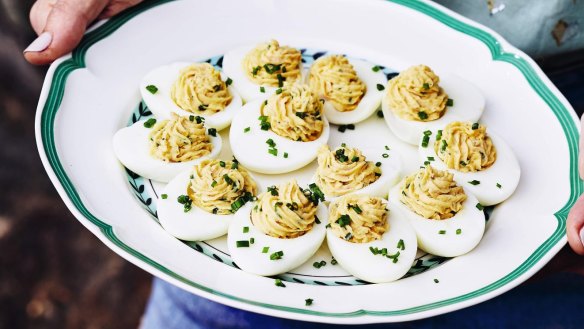
Uova ripiene con tonno e mascarpone (Devilled eggs with tuna and mascarpone)
Here's a fun retro recipe to try. Uova ripiene (devilled eggs) were all the rage in the 1980s when I was growing up in Italy. It is fair to say I have not enjoyed them many times since, but the recipe has been caught in its own time warp for far too long. It's time to revive it – and dust off the piping bag that I never seem to get to play with.
INGREDIENTS
- 6 eggs
- 70g mascarpone
- 80g canned tuna in brine, well drained
- 1 tsp dijon mustard
- 1 tbsp finely chopped chives, plus extra to serve
- salt flakes and freshly ground black pepper
METHOD
- To hard-boil the eggs, lower them gently into a large saucepan of simmering water, bring to the boil and cook for 8-9 minutes. Rinse under cold water to stop them cooking further and leave to cool.
- Peel the eggs and cut them in half lengthways. Scoop out the yolks, place them in a bowl and mash well with a fork. Add the mascarpone, tuna, mustard and chives. Season with salt and pepper to taste and mix to a smooth paste.
- Fill a piping bag with the egg-yolk mixture, then choose your preferred nozzle. Pipe the egg-yolk mixture into the egg-white cavities. Alternatively, you can fill each egg-white cavity with teaspoonfuls of the egg-yolk mixture. Top with the extra chives and serve.
Makes 12
This is an edited extract from The Italian Home Cook by Silvia Colloca, published by Plum, RRP $44.99, photography by Rob Palmer. Buy now